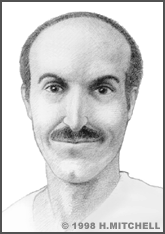Arthur Ganson
We have seen how American art and invention can complement each other, from Harriet Hosmer and Caroline Brooks, to Patricia Billings and Temple Grandin, Arthur Ganson’s body of work is another example of how art and invention exist simultaneously in a single piece.
Born in Hartford, Connecticut in 1955, with a Bachelor of Fine Arts from the University of New Hampshire (1978), Ganson has been creating mechanical sculptures for over twenty years. Ganson's creations are kinetic: that is, they move, either by a motor or with the help of a viewer, who pushes a bar or turns a crank to bring the piece to life.
Ganson sees himself as a combination of "mechanical engineer and choreographer." His sculptures are often composed of an extensive amalgam of wires, wheels, gears, grease, paper or steel, as well as natural objects like eggshells and feathers, whose intricate interplay could be used to teach physics, especially the transfer of energy. Moreover, many of Ganson's works move in waves, or in circles, inviting contemplation of metaphysical questions of time, change, and cycles of creation and destruction. One critic has described Ganson's work as "Rube Goldberg meets Jean-Paul Sartre."
Ganson's work is not easy to describe, due to its complexity as well as its effect. In one sculpture (1997), mechanical arms whirl bright yellow scraps of wood in six seemingly incongruous orbits within a black void, until the scraps are swung into the center, where they fit perfectly together to form a small chair, which after a split second explodes only to fall back together again. "Cory's Yellow Chair" serves as an object lesson in energy and entropy.
Arthur Ganson has exhibited his work across the country, including a piece permanently installed at Inventure Place, the National Inventors Hall of Fame, and a permanent collection at the MIT Museum.


